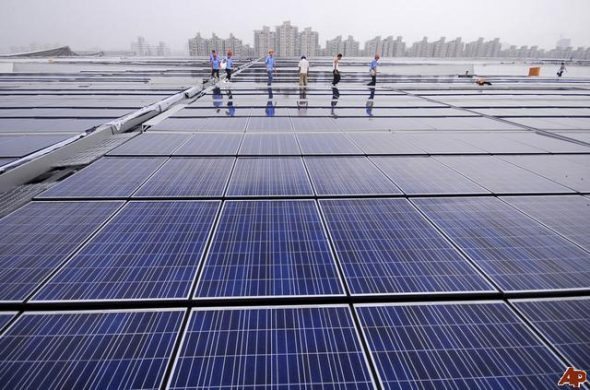China’s first pilot emissions trading scheme was launched on June 18 in Shenzhen. Five other pilots – Beijing, Tianjin, Shanghai, Hubei and Guangdong – are also expected to be launched this year. Only Chongqing is yet to finalise an opening date. All face great problems: they are market systems in a non-market economy. But can those challenges be overcome?
Government advance, market retreat
Previously, China has relied primarily on government regulations or interventions to control its carbon emissions. There were bad memories of such interventions: towards the end of the 11th Five Year Plan, some local governments took the extreme measure of cutting off power supply to fulfil their emissions reduction targets. But these are isolated cases and are unlikely to happen again after the government openly apologised for the wrong doing.
The broader picture is that the government’s major carbon-saving campaigns – including renewable energy subsidies and the “large substitute small (LSS)” program that intends to improve power generation efficiency – have helped China become a frontrunner in clean energy investment. In fact, research done by The Productivity Commission found China’s renewable energy subsidies are much more cost-effective in reducing carbon emissions than similar subsidies in seven other advanced economies; namely, the US, UK, Germany, Australia, New Zealand, Japan and South Korea.
As China’s government-led carbon policies advance, some of the major existing emissions trading systems have to battle for survival. Earlier this year, a Bloomberg report speculated there is a 32% chance Australia will lose its hard-fought carbon pricing scheme at the election in September. Meanwhile, the European Parliament has just recently voted against a bill to reduce the number of permits floating on the EU-ETS, dropping the continent’s carbon price to a new low.
It seems a risky step for China to move from government-led mitigation mechanisms to a market-based one, especially considering the technical challenges ahead.
Technical challenges with Chinese characteristics
One of the defining challenges is minimising the risk of permit oversupply. Issuing more permits than there are emissions will render the permits worthless. The government needs to resist industrial pressure to oversupply, and get its emission projections right. Resisting industrial pressure can be achieved with discipline and skill, but predicting the future cannot be achieved without luck. China’s lower-than-expected growth rate in the first quarter of 2013 also signals the danger of over-optimistic permit allocation.
In fact, permit oversupply seems destined to trouble Shenzhen. Thomas Reuters Point Carbon, a specialised consultancy in climate policies, estimates Shenzhen’s issued permits are likely to exceed forecasted emissions by 10 million tonnes over the three years between 2013 and 2015. Shenzhen’s plan is to adjust permit allocation after companies’ performances are observed – something the EU-ETS has so far failed to deliver.
Another defining challenge is to overcome some institutional barriers so price signals are felt. The country’s electricity sector, which accounts for around 12.5% of global carbon emissions, operates under strict government command. In general, governments of various levels decide the quantities generators sell and the prices they receive. In addition, power dispatching policies generally disregard the fuel type or the efficiency of the power suppliers. Such institutional settings limit passed-on costs and nullify the impact of the carbon price on the demand side.
Shenzhen plans to circumvent this barrier by covering both direct and indirect emissions, letting producers and consumers each pay a share of the total carbon price. Careful monitoring and calculations are needed to avoid levying the carbon price twice or charging the producers or the consumers unfairly.
The ETS pilots are there to design and test different solutions to these technical challenges. But given the difficulties involved, is setting up an ETS really worth the efforts?
The necessity of an ETS in China
China has to pursue an ETS for at least the following three reasons.
First and foremost, an ETS holds the promise of delivering the same level of emissions at least cost. The Australian Productivity Commission report found China’s renewable energy subsidies are more cost-effective than its rich-world equivalents. But it also found that carbon pricing is still by far the most cost-effective way of reducing carbon emissions.
Given China’s high emissions level, a small increase in abatement efficiency can lead to large savings economically. This is particularly important considering China is still a developing country.
Second, the low hanging fruits are soon to be picked out. A study I performed with Yinhua Mai of Monash University found China’s “large substitutes small” program will not lead to the same rate of efficiency improvement in the coming 10 years as it did over the past 10. This is due to the shrinking share of small and inefficient power plants and the closing efficiency gap between China’s and the world’s most efficient generators.
Renewable energy sources, on the other hand, possess huge potential for energy-saving. The price effect is important because a rising cost for carbon encourages people to improve coal-use efficiency, switch to renewable energy sources and adopt energy saving measures.
Third, ETS building could signify the need for further deregulation in the energy market. For example, instead of covering both direct and indirect emissions, a better way to make sure price signals can get through is to grant more autonomy to companies, allowing them to make investment, production and buying and selling decisions basing on market signals. Such reforms could not only enhance the efficiency of the ETS, but also the efficiency of the whole energy market.
However, price mechanism alone may not be sufficient either. Thus both market tools and mandatory commands are being developed. Finding the right mix and complementarity are important. One thing is clear: China is determined to deal with environmental concerns because they have clearly become hard constraints for future economic growth.
This article is based on a research paper which you can read here.
Shenghao Feng is a PhD candidate (economics, climate change) at Australian National University. He does not work for, consult to, own shares in or receive funding from any company or organisation that would benefit from this article, and has no relevant affiliations.![]()
This article was originally published at The Conversation.
Read the original article.








